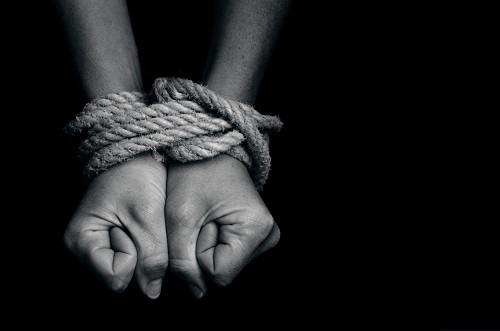By
Introduction
With the massive influx of refugees on Europe’s door step, the EU has become more vulnerable than it was during the outbreak of World War II. Inspite of hosting “major flourishing developed economies” the EU is continuously haunted by its past. With a history of “flourishing” organized crime networks and notorious “human trafficking rings,” law enforcement agencies have more rampant issues to deal with. Using the ongoing refugee crisis as a “cloak” for organized crime in relationship with dormant human trafficking groups along with their recent allies “Wahhabi militants,” has resurfaced again to remind the EU of its past.
Today, organized crime has the second largest, lucrative and fastest developing networks in the world, their “illicit activities” are not just limited to trafficking of humans, but extend to labour, slavery and sexual exploitation followed by trafficking of organs through blackmail, kidnapping and extortion, using any and all means necessary. Moreover, 56% of women are victims of sexual exploitation, threatening and slavery in few of the developed economies whereas, Interpol and Europol have already alarmed local and regional law enforcement agencies of a spike in women trafficking in the EU, particularly after the refugee crisis.
It is also important to note that on many occasions law enforcement agencies also get confused in cases pointing to human trafficking and migrant smuggling as both the incidents involve exploitation by the “handler,” as there involves deep linkages in nations the victim is smuggled. Today, particularly after the migrant crisis, transnational organized crime has resurfaced. This retribution has further enhanced their “operational mechanism,” making them more violent and active than ever before.
These groups have become ruthless and identifying their key ringleaders and operations has become more complex than ever. Furthermore, these groups are reinforced by socio-economic conditions such as poverty, areas with poor law enforcement activity, inequality in gender and gender biasness along with rampant violence against women, conflicts and regional diasporas, poor social integration policy and poor governance. Due to the aforementioned factors, they have come from being crime factions to “actors demanding profits,” hovering under “migrant crisis.”
The resurfacing of transnational organized crime points to the failures of law enforcement agencies and porous border security preparation followed by inadequate cooperation and coordination of inter-agency interaction and failure of a “working-together” mechanism. Ineffective and inefficient law enforcement policies have created a vacuum in trade centric areas, particularly those with adjoining neighbouring countries, and thus these problems inhibit EU nations economically and socially when they start to expand beyond containment. This issue, inspite of numerous actions from the OSCE and other inter-governmental agencies, has minimal effects. The issue is a grave concern to member nations of the EU, particularly when these organized crime factions have joined hands with “Wahhabi militants” and “radicalised local nationals,” particularly the youths.
Changing trends
Today, the human trafficking factions are on an “open season,” looking for youths, particularly unemployed and living, hailing either from marginal communities or foreign nationals docked as “migrants.” They further increase their network by involving acquaintances, relatives, neighbours and do not limit themselves to extortion or intimidation if they are challenged. Particularly in Russia, the transnational organized crime units are often headed by women, or engaged with large local women participation, in an effort to strengthen their control on smuggling of drugs or prostitution. Victims of trafficking, particularly women have been largely seen as primary actors, because of poor reintegration and rehabilitation policies of the state or of law enforcement agencies responsible for their safety, they have fewer opportunities to earn. Inspite of being “aware” of their roles in prostitution and women racketeering, these “former victims turned principle actors” become viable for top leadership positions.
It is important to note that every trafficking racket has their “unique operational” mechanism. Today, particularly in Europe, over 279, 000 people have been trafficked to countries such as Venezuela in South America. This further states that in a time span of over two years, more than 70, 000 women would be trafficked. “Once victims turned recruiter” use sleeper agents to lure women from a particular region and meticulously execute their operations inspite of law enforcement vigils. This, on a growing scale, has become a global business, spreading across to Asia, particularly India and China. There is a phenomenal increase in trafficking of Chinese women in Europe and, after the arrest of many trafficking gangs in Italy, turns out to be the “highest money making business.”
The situation today
Victims terrified by traffickers, human racketeers and transnational organized crime syndicates, have sought various redressals from the law enforcement agencies and top judicial officers in an effort to prevent another encounter. Their extensive engagement in the human trafficking syndicates not only questions the efficiency of law enforcement and judicial system, particularly in the EU, but also focuses on the exponential growth of traffickers, sleeper agents, their “hidden connections” along with poor enforcement mechanisms. Inefficient border patrols and developed economies bordering the host country prove to be more cost-effective than smuggling abroad. With recent surge of refugees in Europe, human traffickers have used it as a “camouflage” against law enforcement which proved to be a great boom for them. Their operation is supported by three pillars: smuggle the victim with the incoming migrants, free unchecked movement throughout the whole of Europe, and entering the country again as a migrant, in out and in again without raising suspicion.
It is important for law enforcement agencies to understand that their methodologies have evolved with their resurfacing and they have now evolved particularly what intelligence agencies term as “hiding in plain sight.” Moreover, they have become more complex and efficient in their operation, covering vast regions of Europe without raising suspicion. They have begun working in structural hierarchies with sleeper units doing most of the ground work. Their frequent movements and links with organized crime factions make them virtually “invisible” even for justice administration and law enforcement agencies to put a trace on their whereabouts.
With globalization, unfortunately, it too has been an important factor for the rise of human trafficking syndicates, smuggling migrants in and out of conflict nations such as Syria and Libya, extensive, never ending conflicts one of the principle reasons for their rise. Using digital technology as their advantage, human trafficking syndicates have expanded, mastering the art of social blogging and using social media websites to their advantage. This reminds the law enforcement agencies and regional judicial officers to upgrade their means and methods too, in an effort to increase cooperation and coordination with local, national and international partners such as Europol and Interpol; it being important therefore for regional agencies to use the digital age to their advantage.
It is also important to note that these human traffickers do not limit themselves to theatrics or lucrative advertisements, job opportunities, or child pornography to lure their prey. They too maintain large caches of illegal arms and ammunition to blackmail or threaten large companies. The use of digital means has rather turned into a battle between law enforcement agencies and human traffickers, which unfortunately, the former seems to be always one step behind.
Policy makers must understand that human traffickers do not function always within their nationality. Women smuggled from many non-EU countries are enrolled in the refugee database and are registered within the applied nation as a refugee/migrant, which after some time, these traffickers make their citizenship permanent. Policy makers should note that not just victims, but traffickers too mostly hail from EU member nations, giving them an edge over law enforcement agencies who in their initial hours of investigation consider the possibility of an “outsider.” Trafficking in the EU has now turned into a large black market, where the victims either come from EU member nations or hail from other non-EU member countries across the ocean.
The way ahead
Today, human trafficking in the 21st century is modern slavery, heinous, but is none the less active and continues to undergo rapid evolution in tactics, in an effort to “cloak” from law enforcement agencies. It is important for policy makers from various regional and local law enforcement agencies to understand and effectively analyse the tri-relationship of “human trafficking-transnational organized crime-Wahhabi militants/radicalised youths.” Their working methodologies lie principally on preventing these crimes from happening, prosecuting those responsible and protecting the victims from drifting back in the nexus through lucrative, beneficial and effective rehabilitation and reintegration policies, so that their past does not affect their future.
Policy makers must see this through a multifaceted prism while also acknowledging the role of socio-economic factors in favour for these traffickers to rise. It is not just the responsibility of the state but also for designated agencies to interact with local civil society organizations in an effort to reintegrate the victims in their community.
In order to address the root cause of the issue, law enforcement agencies need to evolve in their tactics, to begin with, by using technology as their advantage and extending their boundaries for cooperation and coordination, using all available information on the racketeering groups, experts from all fields and intelligence officials. They need to further upgrade their commitment to “protection, prevention and prosecution” mandate by inviting experts in judicial, law enforcement and international cooperations such as the UNCAC. Upgrading the enhanced border safety nets and experienced, dedicated trafficking officers posted on borders would further minimise traffickers’ movement but would also make them target sleeper cells and handlers responsible for trafficking their victim.
Looking over the socio-economic fronts, it is a must for law enforcement agencies to interact with the communities as they are the key eyes and ears on the ground. Through training and proper knowledge, the masses can themselves prevent acts of migrant trafficking, sexual violence, exploitation and child labour.
As mentioned above, there is an absolute need to strengthen law enforcement interaction within different agencies of the members of the EU. Communication plays a crucial role, especially when the “first responders” are on the scene, hence officers need to effectively communicate towards their advantage, which not only assists in cross border migration but creates “trust” between law enforcement agencies. Further strengthening the vigil on boundaries enforcement mechanisms would certainly prove to be effective.
Anant Mishra
Anant Mishra is a security analyst with expertise in counter-insurgency and counter-terror operations.
Richa Chadha
Richa Chadha has been a journalist for over a decade, starting her carrier with The Pioneer and leading the ranks with some of the most important leadership positions in nationally reputed papers such as The Hindustan Times, credited for many important stories during her tenure at Hindustan Times. Armed with political in-depth understanding, she comes with a rich of experience of covering national and global issues.




I relate to the situation of these refugees, abused women and children, since I was a victim for kidnapping. It took me five years to recover and stand to the public and social media, the trauma , the experience that created scars. Now I stand to walk hand in hand with these women, victims of kidnapping, harassment or being abused or used on selfish events using the aid of our roots, our Nation, the UN welfare. I say to you, this the time for us to restructure, abstract movement and resettlement guided by people you, authors who stands for humans rights, authors and UN members who are here with tasking every step to help them build their future, away from danger. With I say, I am with you all the way.